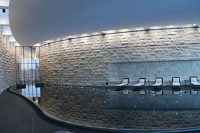“It took me one year to get the job at Chateau Appony, after calling the new owner every month,” said Dusan Stevlik of Cremarfil Marble Products. “My company was absolutely new on the Slovak market. When I first came to the Chateau, it was the owner’s wife who was making decisions about what stone would be applied. I explained some technical points about exploration, processing and installation of natural stone.”
The project features Jura limestone from V.M. Kaldorf of Germany and Crema Marfil marble from Francisco & Segura Galvan a.s. of Spain, and Stevlik explained that the quality of production was a key point to stress to the owners of Chateau Appony. “[In addition to] their beauty, they are 100% calibrated at a European factory, where I know what I am getting, and most important, what the client will get.”
Installation details
Once the decision on the materials was made, Crema Marfil Products assembled just the right team for the installation. “[There was] a short conversation between me and the owner,” Stevlik said, adding that he stressed the need for a quality installation. “I told him that I would get the best tiler from Spain, which I used to work with in Palma de Mallorca on luxury resorts, including houses of Michael Schumacher, Claudia Schiffer and the President of Real Madrid.”
Stevlik assembled a team of five crew men, who would be responsible for installing the two varieties of marble throughout Chateau Appony.
The project required a total of 36 tons of marble, including nearly 5,000 square feet (450 square meters) of Crema Marfil marble and over 3,200 square feet (300 square meters) of Jura Gold limestone.
All of the stone flooring — Crema Marfil marble and Jura limestone — was utilized as tiles measuring 60 x 40 x 1.5 cm as well as wall bases. Meanwhile, the Crema Marfil was used for treads and risers and landings on the feature staircases throughout the property. It was also used for architectural elements such as window sills.
While the flooring was shipped in tile format, the installation team also custom cut pieces as needed for elements such as mosaics and medallions. The conditions of the jobsite also mandated some field cutting and adjustments by the crew.
“The biggest difference between a new hotel and a restoration are the surprises you find,” Stevlik said. The walls of the structure did not form a straight line, and there were a number of areas where the stone was set on a curve.
Additionally, the historic nature of the site meant that the restoration had to be conducted in conjunction with the local heritage associations. The installation took a total of one month, plus two weeks for the custom stone elements.
Now complete, Chateau Appony not only serves as a top-notch hotel and restaurant in the region, but it is home to the historic library collection of the Appony Dynasty — Bibliothecu Apponianu — which is said to be one of the greatest libraries in Central Europe.
Owing back to the historic days of the structure, Stevlik also hosted a fashion shoot at Chateau Appony, which carried a classic premise. “We were shooting for two days with five models — using all kinds of themes in which to transfer the atmosphere of Royal Habsburg Empire combined with a modern lifestyle of fashion and design.”









